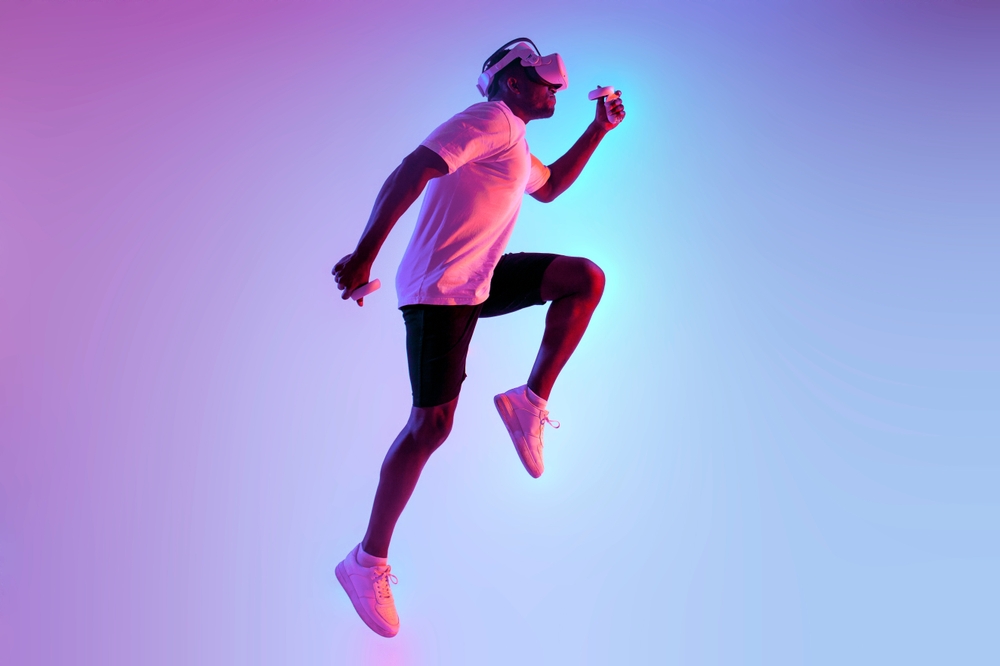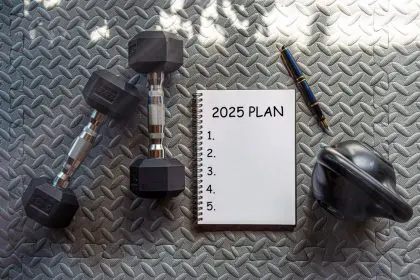Every long-distance runner knows about “the wall,” that brutal moment when your legs feel like lead, your mind wants to quit, and finishing the race seems impossible. It usually hits around mile 18 or 20 in a marathon, turning what should be a triumphant finish into a mental and physical battle for survival.
But what if a headset could help you run right through that wall without even noticing it was there? That’s the revolutionary idea behind virtual reality marathons, a new frontier where cutting-edge technology meets endurance sports to fundamentally change how we experience long-distance running.
By immersing runners in visually stimulating, gamified environments that respond to their movement, VR may actually help distract the brain, ease the perception of fatigue, and push performance farther than traditional training methods ever could. The technology isn’t just changing where we run, it’s changing how our minds process the experience of running itself.
Your brain gets transported while your body keeps moving
Instead of staring at a boring treadmill screen or dodging the same neighborhood potholes, imagine jogging through a mystical redwood forest, racing through a futuristic city skyline, or even bouncing across the lunar surface in low gravity. With a VR headset, these impossible experiences become your running reality.
VR marathon experiences create fully immersive environments where every step you take moves you forward through stunning virtual landscapes that respond to your pace and effort. If you speed up, the scenery rushes past faster. If you slow down, you have more time to appreciate the incredible details of your virtual surroundings.
Interactive elements within these virtual worlds can include anything from collecting power-ups that give you motivational boosts to racing against virtual pacers who help you maintain your target speed. Some systems even incorporate weather effects, wildlife encounters, and changing time of day to create truly dynamic running experiences.
The synchronization between your physical movement and the virtual environment creates a sense of presence that makes your brain forget you’re actually running in place on a treadmill. This disconnect between physical reality and perceived experience is where the real magic of VR marathon training happens.
Science explains how VR tricks your mind past exhaustion
Research shows that perceived effort plays a huge role in endurance performance, often more important than actual physical capability. When your mind focuses on fatigue, discomfort, or boredom, your body responds by slowing down even when it’s physically capable of continuing.
Virtual reality taps into this mind-body connection by providing intense sensory stimulation that captures your brain’s attention and redirects it away from fatigue signals. Your conscious mind becomes so engaged with navigating the virtual environment that it has less bandwidth available to process and amplify discomfort.
Early studies suggest that VR can reduce how hard a run feels, shorten the perception of time, boost emotional engagement and motivation, and help athletes mentally detach from pain signals. The technology essentially hijacks your brain’s attention system and uses it to enhance rather than hinder your performance.
The immersive nature of VR also triggers flow states more easily than traditional running environments. When you’re fully absorbed in a virtual world, you enter that coveted zone where time seems to stop and physical effort feels effortless, allowing you to maintain higher intensities for longer periods.
Gamification transforms suffering into entertainment
VR marathon platforms incorporate sophisticated gamification elements that transform the traditionally solitary and often painful experience of long-distance running into something that feels more like playing an engaging video game than enduring a workout.
Achievement systems reward you for hitting distance milestones, maintaining target paces, or exploring new virtual territories. These constant positive reinforcements keep your motivation high throughout runs that might otherwise feel monotonous or overwhelming.
Multiplayer features allow you to run alongside virtual avatars of other real runners from around the world, creating social connections and friendly competition that can push you to perform better than you would alone. You might find yourself keeping up with someone from another continent just to stay in their virtual pack.
Dynamic storylines and adventure elements can turn a simple training run into an epic quest where reaching your distance goal means saving a virtual world or completing an important mission. This narrative framework gives deeper meaning to the physical effort you’re putting in.
Athletes and everyday runners embrace virtual training
Amateur runners are using VR to eliminate the boredom of indoor training, especially during bad weather or when safety concerns make outdoor running impractical. The technology allows them to maintain consistent training schedules regardless of external conditions while making the experience enjoyable rather than tedious.
Rehabilitation patients recovering from injuries are finding VR particularly valuable because it allows them to gradually rebuild stamina and confidence in a controlled, engaging environment. The distraction provided by virtual worlds can help them push through discomfort that might otherwise limit their recovery progress.
Elite athletes are experimenting with VR for visualization training and race simulation, using virtual environments to practice pacing strategies and mental preparation for specific race courses. Some are even using VR to train at virtual versions of actual marathon courses before competing in the real events.
Fitness technology companies are creating comprehensive VR fitness ecosystems that combine treadmills, heart rate monitors, and haptic feedback systems to create full-body experiences that blur the line between exercise and entertainment.
Technical challenges still need solutions
Motion sickness affects some users, particularly during longer sessions or when the virtual movement doesn’t perfectly match their physical movement. This can limit the effectiveness of VR training and make some people unable to use the technology for extended periods.
Wearing a headset while sweating presents practical challenges including fogging, slipping, and hygiene concerns that manufacturers are still working to solve. Current VR headsets aren’t designed for the intense physical activity and perspiration that marathon training involves.
The technology remains expensive and not widely accessible, limiting adoption to early adopters and specialized training facilities rather than becoming mainstream training tools. Most serious runners still can’t afford or access high-quality VR running systems.
Current VR setups are primarily treadmill-based, which limits the natural feel of outdoor running and eliminates elements like wind resistance, terrain variation, and true directional changes that are integral parts of real-world running experiences.
The future of immersive endurance training
As VR hardware becomes lighter, more comfortable, and more affordable, we’re likely to see widespread adoption of virtual reality training across all levels of distance running. Future systems may incorporate haptic feedback, scent generation, and temperature control to create even more realistic experiences.
Artificial intelligence could personalize virtual environments based on individual psychological profiles, automatically adjusting scenery, music, and challenges to optimize each runner’s motivation and performance. Your VR system might learn exactly what types of virtual experiences help you push through difficult training sessions.
Mixed reality systems that combine virtual elements with real-world running could offer the best of both worlds, allowing outdoor runners to see virtual pacing guides, receive real-time coaching, or participate in augmented races while still experiencing natural terrain and weather.
The integration of biometric monitoring with VR environments could create systems that automatically adjust the virtual experience based on your physiological state, ramping up motivational elements when you’re struggling or providing calming environments when you need to recover.
Redefining what it means to hit the wall
Virtual reality marathons represent more than just a novel training tool, they represent a fundamental shift in how we understand the relationship between mind and body in endurance sports. By proving that perception can be manipulated to enhance performance, VR is revealing new possibilities for human athletic achievement.
The technology suggests that many of our perceived physical limitations may actually be mental constructs that can be overcome through strategic sensory manipulation. If running “the wall” is largely a psychological phenomenon, then VR provides a powerful tool for rewriting that psychological script.
As virtual reality technology continues to evolve, it may become as essential to marathon training as proper shoes and nutrition planning. The runners of the future might spend as much time training their minds through virtual experiences as they do conditioning their bodies through physical miles.
The ultimate promise of VR marathons isn’t just making training more enjoyable, it’s expanding our understanding of human potential by showing that sometimes the best way past a barrier isn’t to break through it, but to run somewhere else entirely where that barrier doesn’t exist.
















